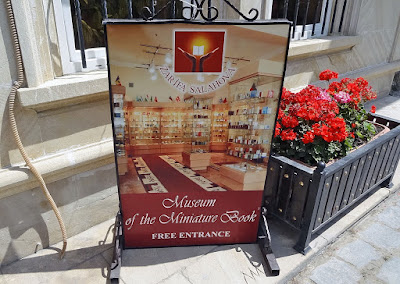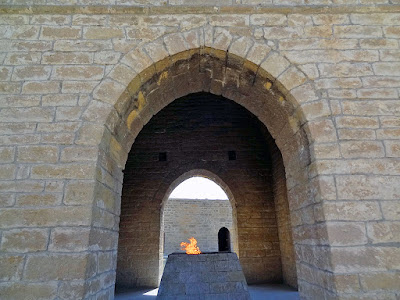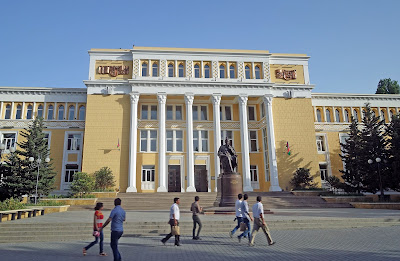June 8: Baku, Azerbaijan
First, a little about Azerbaijan in general. It's often listed as one of the world's more repressive countries, and it's sitting on a lot of oil and natural gas. This combination means that the government can spend a lot of money building infrastructure and buildings, and making things look good. In addition, Baku was about to host the first European Games. I'll bet you didn't know Azerbaijan was in Europe--neither did I or most people with a knowledge of geography. So, Baku was very spiffed up for my arrival--lots of new/renovated buildings and immaculate streets.
The flights from JFK to Kiev and Kiev to Baku were uneventful. However, while I was in the Kiev airport, I was eating a piece of chicken (but not Chicken Kiev), and a crown popped off one of my teeth, not a good way to begin 12 days in the Caucasus. Fortunately, I was able to recover the crown and put it in a plastic bag. More on this shortly.
My flight from Kiev to Baku landed in Baku at about 1:00 AM on Monday morning. I was greeted by a new, spectacular airport terminal at
Heydar Aliyev International Airport.
Heydar Aliyev was one of the first leaders of post-communist Azerbaijan (even though he was a communist), and his son now leads the country.
My personal measure of the repressiveness of a country is how many buildings are named after the leader and how many billboards have his picture on them--by this measure, Azerbaijan qualifies as quite impressive, and repressive. By the way, I found out that Heydar Aliyev died in Cleveland, of all places.
 |
| Terminal at Heydar Aliev International Airport at 1:00 AM |
The original itinerary for the trip indicated that we would be staying at the Central Park Hotel in Baku. About 2 weeks before the trip we got an updated itinerary that said the hotel had been changed to the Admiral Hotel. The driver who picked me up at the airport (and who didn't speak a word of English), took me to the Central Park Hotel. I tried to explain to the desk clerk that my itinerary said that I was supposed to be at the Admiral Hotel (about 3 miles away). She said that my name was on their reservation list and since it was 2:00 AM, I might as well spend the night there and sort things out in the morning. This made excellent sense. It turns out that they had changed the hotel back to the Central Park, so I was in the right place.
 |
| Central Park Hotel |
 |
| Lobby of the Central Park Hotel |
 |
| Partial view of Baku from the hotel |
I arrived in Baku the day before the tour began so I had the first day on my own. I had originally planned to spend the day wandering central Baku, but my first order of business was to find a dentist and get my crown put back in. I went to the front desk of the hotel and asked where I could find an English-speaking dentist, and they had no idea. So, left to my own devices, I Googled "Baku dentist English". The first listing that came up was a place called "5A Dent Cosmetic Dentistry". According to the map, it was only about 5 blocks from the hotel, and in the general direction of where I would be going anyway. So, I set off on my journey.
 |
| On the way to the dentist |
"
5A Dent" (I don't know where the name came from) was on the second floor of a commercial building near the center of town. I went in and asked the receptionist if she spoke English. She waved at me to wait and got a dental assistant, who spoke excellent English. I explained the problem and she told me that the dentist could fix it right then. She took me into the treatment area, which was as modern as any I have ever seen. The dentist, who also spoke excellent English, told me that he could replace the crown. I asked him how much it would cost and he told me $1,200. I then asked him if he could just glue the crown back in, and how much it would cost. He said he would be glad to glue it in and it would cost $40. Needless to say, I opted for the less expensive treatment. In 15 minutes I was back on the street with a repaired crown.
 |
| The excellent staff at 5A Dent, who couldn't understand why I was taking their picture |
From the dentist's office I walked a few blocks to Fountain Square, which is the main "meeting place" in Baku. It's a pleasant park surrounded by mostly modern buildings, and contains the typical McDonalds and KFC outlets that you can find in any civilized city.
 |
| Fountain Square |
 |
| Pricing a "Biq Testi" and a "Miks Boks" at Mickey D's |
The Azerbaijan language is close to Turkish. The good news is that it is written with Latin characters. The bad news is that it is almost unintelligible. It does, however, contain one of my favorite characters, "Ə", which is pronounced "eh". Thus, the Great Leader's name is correctly spelled
Heydər Əliyev.
From Fountain Square, I walked a couple of block to the
Old City part of Baku. The Old City dates from the 7th or 12th century, depending on who you ask. I took a quick stroll through the Old City, since I knew we would be spending time there on the tour.
 |
| One of the walls of the Old City |
 |
| Some tombs inside the Old City |
 |
| The Old City, with the Flame Towers (more on them later) in the background |
 |
| Vendors in the Old City |
From the Old City, I walked to the waterfront, on the Caspian Sea. Baku has a beautiful park, called "
Bulvar" that runs the length of the waterfront.
 |
| The Four Seasons Hotel, next to Bulvar |
As I mentioned earlier, Baku was getting ready to host the first European Games (which started the day after we left), and the city was all decked out for the games. "Baku 2015" signs, sculptures, and shirts were everywhere. I was told that they were shipping all of the undesirables out of town for the games, and weren't letting anyone in the city unless they lived there or were a tourist.
 |
| A Baku 2015 sculpture in front of the Flame Towers |
The Flame Towers, which appear in a few pictures on this page are on a hill just above the town. Presumably the design represents the Azerbaijani oil and gas industry, and the buildings are lit up like flames at night.
My first stop on the Bulvar was the Carpet Museum, which looks like a rolled-up carpet. Assuming that we would visit on the tour (which we did not), I didn't go in.
 |
| Carpet Museum |
 |
| A pavilion in the Bulvar |
The center of Baku was very modern, with a lot of construction going on. In addition to constructing new buildings, they have renovated most of the Soviet-era buildings,at least on the outside, so Baku is visually more impressive than other post-Soviet cities.
 |
| Along the main road paralleling Bulvar |
 |
| Park Bulvar Shopping Mall |
From Bulvar, I headed back to my hotel.
 |
| A park and bank building on the way back to my hotel |
 |
| Heydar Alyiev (gee, that name sounds familiar) Theater |
My hotel was on a residential street a few blocks from the center of town. Most of the rest of the buildings on the street were from the Soviet era and had not been renovated. Apparently they concentrated on renovating the buildings on the main streets.
 |
| The building next to our hotel |
 |
| View from my hotel room showing the back of the building next door |
After I got back to the hotel, I met our guide and had a very unremarkable dinner with the members of the group who had arrived.
 |
| Gurban, our guide (left), and our driver |
After dinner I took a walk a couple of blocks away to a Fuzuli Park (more like a pedestrian mall), which was on the site of the Jewish district of Baku. The Jews survived World War II, but most of them left when they could emigrate to Israel in the 1970's. Below are some views of the park.
June 9: Baku, Azerbaijan
Our remaining tour mates showed up for breakfast, and after eating, we left for
Gobustan National Park, an area about an hour south of Baku that features a number of petroglyphs (rock carvings). Our transportation in Azerbaijan, as it would be in Georgia and Armenia, was a 10 passenger van. Since there were only 5 of us on the tour, plus the guide and driver, we had plenty of room to spread out.
 |
| The (excellent) museum at Gobustan National Park |
In addition to petroglyphs, the park contained some inscriptions left by the Romans when they passed through in about 780 AD. Apparently this was as far east as the Romans ever got.
 |
| Roman inscription |
 |
| A general view from the park |
The petroglyphs date back 10,000 years.
 |
| Some petroglyphs |
 |
| More carvings |
 |
| Local fauna |
On our way back to Baku, we passed by the entrance to the
Khazar Islands, a development where they were building artificial islands, similar to the ones in Dubai. Unfortunately, the entrance was as close as we got.
 |
| Entrance to Khazar Islands |
Our next stop was the
Bibi Heybat mosque on the outskirts of Baku. The mosque itself is new, having been built in the 1990's. Although Islam is the predominant religion in Azerbaijan, it's not a particularly religious country and there are not nearly as many mosques as there are in countries in the Middle East. And there were plenty of alcoholic beverages available (but not in the mosques).
 |
| Bibi Heybat Mosque |
 |
| Inside the mosque |
Azerbaijan is sitting on a lot of oil and gas and there are a lot of oil wells in and around Baku as well as offshore.
 |
| Oil wells in Baku |
After lunch in the Old City, we went to the Azerbaijan State Art Museum, which was pretty good, as art museums go. Unfortunately we couldn't take any pictures in the museum.
 |
| In front of the art museum |
 |
| Executive office of the President (which apparently I wasn't supposed to take a picture of) |
 |
| Some restored 19th century buildings across from the Art Museum |
From the museum we drove to Bulvar, where we boarded a boat for a short cruise in the Caspian Sea.
 |
| Central Baku |
 |
| Our group (except for me), resting in the park |
Below are a few views of the Baku shoreline from the cruise boat.
After the cruise we walked back to our hotel.
 |
| Baku taxis, purchased from London |
 |
| More publicity for the European Games |
 |
| Typical street corner in Baku |
 |
| Kapital Bank and a traffic sign |
For dinner, we ate in the Old City, at the Caravanserai Restaurant, which dates from the 14th or 15th century. We were entertained by some musicians, a fire eater, and a suspiciously non-Azerbaijani-looking belly dancer.
 |
| Standing on a rack of knives |
The food we had in all three countries was similar. Every meal started with a plate of sliced tomatoes and cucumbers, and a plate of local cheese and bread. In most cases there was an eggplant appetizer and a cole-slaw-like salad. The main course was usually some sort of grilled meat. There were at least 6 or 7 dishes at each meal.
After we got back to the hotel, I found a window that had a view of the Flame Towers and took a couple of shots.
June 10: Baku, Azerbaijan
(For reasons that would take too long to explain, I managed to delete all of the pictures that I took before dinner on this day
. Most of the pictures from this day were generously given to me by one of my tour mates.)
After breakfast, we headed to a hill on the western side of Baku that contained several sights, including the Flame Towers, the Azerbaijani parliament, and a memorial (Martyr's Lane) to the people who were killed by the Soviets in the 1990's.
 |
| Two of the 3 Flame Towers |
 |
| Martyr's Lane |
 |
| Martyr's Lane |
 |
| Monument housing an eternal flame |
 |
| View from the hill of a ferris wheel on the Caspian |
 |
| All of the Flame Towers |
 |
| View of western Baku |
 |
| View of central Baku from the hill |
 |
| Another memorial on the hill |
Our next stop was the Old City, which I had walked through the day before.
 |
| Entrance gate to the Old City |
 |
| Exterior wall of the Old City |
 |
| A sculpture in the Old City |
 |
| Excavation in the Old City |
 |
| Maiden Tower |
 |
| Sculpture in the Old City--this is the back of the head on a sculpture of a poet |
 |
| Some modern art (tea glasses and plates) |
The main attraction in the Old City is the
Palace of the Shirvanshahs, parts of which date from 1411.
 |
| An entrance to the palace |
 |
| Courtyard of the Palace |
 |
| Exhibit inside the Palace |
 |
| Artwork inside the palace |
After lunch, we headed to some attractions just outside Baku.
 |
| Heydar Aliyev (that name again!) Cultural Center |
Our first stop outside Baku was
Yanar Dag ("Burning Mountain"), which is a natural gas vent in the ground that burns continuously. I have to say that it was more interesting in concept than in person.
Next, we went to
Baku Ateshgah ("Fire Temple"), which was a Hindu place of fire worship, and is now a museum. Below are some shots from the temple.
There was a separate building at the temple that housed a restaurant where we stopped for (non-alcoholic) drinks. The interior of the restaurant was very impressive.
Next we drove to
Mardakan Castle, which was built in the 14th century, but is now completely surrounded by a suburb of Baku. Below are some shots of the castle.
After seeing the castle (and picking and eating a bunch of mulberries, which were delicious), we headed back to Baku. Below are a few shots of Baku from the drive.
 |
| The restaurant where we ate |
After dinner, we returned to the hotel without incident.
Next:
Days 4-6--Sheki, Telavi, and on to Tblisi





























































































